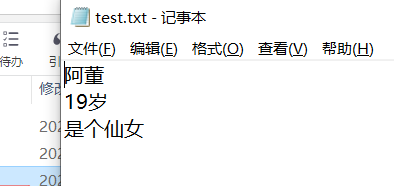文本文件
程序运行时产生的数据都属于临时数据,程序一旦运行结束都会被释放
通过文件可以将数据持久化
C++中对文件操作需要包含头文件 < fstream >
文件类型分为两种:
- 文本文件 - 文件以文本的ASCII码形式存储在计算机中
- 二进制文件 - 文件以文本的二进制形式存储在计算机中,用户一般不能直接读懂它们
操作文件的三大类:(不要写反ofstream和ifstream)
- ofstream:写操作
- ifstream: 读操作
- fstream : 读写操作
写文件
写文件步骤如下:
-
包含头文件
#include <fstream> -
创建流对象
ofstream ofs; -
打开文件
ofs.open(“文件路径”,打开方式); -
写数据
ofs << “写入的数据”; -
关闭文件
ofs.close();
文件打开方式:
| 打开方式 | 解释 |
|---|---|
| ios::in | 为读文件而打开文件 |
| ios::out | 为写文件而打开文件 |
| ios::ate | 初始位置:文件尾 |
| ios::app | 追加方式写文件 |
| ios::trunc | 如果文件存在先删除,再创建 |
| ios::binary | 二进制方式 |
注意: 文件打开方式可以配合使用,利用|操作符
如:用二进制方式写文件
ios::binary | ios:: out
代码:
#include <iostream>
using namespace std;
#include <fstream>
void test() {
ofstream ofs;
ofs.open("test.txt", ios::out);
ofs << "阿董" << endl;
ofs << "19岁" << endl;
ofs << "是个仙女" << endl;
ofs.close();
}
int main() {
test();
system("pause");
return 0;
}
运行结果:
控制台中没有输出任何结果

右击



读文件
读文件步骤:
-
包含头文件
#include <fstream> -
创建流对象
ifstream ifs; -
打开文件并判断文件是否打开成功
ifs.open(“文件路径”,打开方式); -
读数据
四种方式读取 -
关闭文件
ifs.close();
代码:
#include <iostream>
using namespace std;
#include <fstream>
#include <string>
void test(){
ifstream ifs;
ifs.open("test.txt", ios::in);
if (!ifs.is_open()){
cout << "文件打开失败" << endl;
return;
}
第四步:有四种方法,建议第三种
ifs.close();
}
int main() {
test();
system("pause");
return 0;
}
第一种:
char buf[1024] = {
0 };
while (ifs >> buf){
cout << buf << endl;
}
第二种
char buf[1024] = {
0 };
while (ifs.getline(buf,sizeof(buf))){
cout << buf << endl;
}
第三种
string buf;
while (getline(ifs, buf)){
cout << buf << endl;
}
第四种
char c;
while ((c = ifs.get()) != EOF){
//EOF:end of file
cout << c ;//不能加endl,否则会乱码或者读不出来
}
运行结果:
若找不到文件

若找到:

- 利用is_open函数可以判断文件是否打开成功
- if ( ! ifs.is_open)的意思是 if(ifs.is_open() = = false)
二进制文件
写文件
二进制方式写文件主要利用流对象调用成员函数 write
函数原型 :
ostream& write(const char * buffer,int len);
参数解释:
字符指针buffer指向内存中一段存储空间。
len是读写的字节数
代码:
#include <iostream>
using namespace std;
#include <fstream>
#include <string>
class Person{
public:
char m_Name[64];
int m_Age;
char m_Type[64];
};
void test(){
ofstream ofs;// 等于ofstream ofs("person.txt", ios::out | ios::binary);
ofs.open("person.txt", ios::out | ios::binary);
Person p = {
"阿董" , 19, "是个仙女"};
ofs.write((const char*)&p, sizeof(p));
ofs.close();
}
int main() {
test();
system("pause");
return 0;
}
运行结果:

右击

!](https://img-blog.csdnimg.cn/20210130173310962.png?x-oss-process=image/watermark,type_ZmFuZ3poZW5naGVpdGk,shadow_10,text_aHR0cHM6Ly9ibG9nLmNzZG4ubmV0L3dlaXhpbl80ODI0NTE2MQ==,size_16,color_FFFFFF,t_70)

发现是乱码的不用理,只要后序读进去是对的就行

读文件
二进制方式读文件主要利用流对象调用成员函数 read
函数原型:
istream& read(char *buffer,int len);
参数解释:
字符指针buffer指向内存中一段存储空间
len是读写的字节数
代码:
#include <iostream>
using namespace std;
#include <fstream>
#include <string>
class Person{
public:
char m_Name[64];
int m_Age;
char m_Type[64];
};
void test(){
ifstream ifs;// 等于ifstream ifs("person.txt", ios::out | ios::binary);
ifs.open("person.txt", ios::in | ios::binary);
if (!ifs.is_open()){
cout << "文件打开失败" << endl;
}
Person p;
ifs.read((char*)&p, sizeof(p));
cout << "姓名: " << p.m_Name << endl;
cout << "年龄: " << p.m_Age << endl;
cout << "类型: " << p.m_Type << endl;
ifs.close();
}
int main() {
test();
system("pause");
return 0;
}
运行结果:
若找不到文件
若找到

注意
1、文件读取失败时,一定要记得return;
否则:
2、二进制写文件有const,读没有
ofs.write((const char*)&p, sizeof(p));
ifs.read((char*)&p, sizeof(p));
3、
in>>noskipws; //读入字符时,不忽略空格 ,逐字符读取
ifstream in(file); //从外部文件读取文本
dataset.clear();
//DataSet.Clear 方法: 通过移除所有表中的所有行来清除任何数据的 DataSet
in>>skipws; //恢复默认值
in.close();